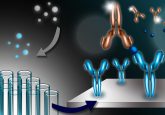New acoustic sensor shows promise for biological and chemical analysis

Testing for cancer biomarkers or distinguishing chemicals may be significantly easier in the future, thanks to a new microscopic acoustic device that has been dramatically improved by the US Department of Energy’s Argonne National Laboratory (IL, USA). The team, in collaboration with scientists at the University of South Florida (FL, USA), has developed a new form of surface acoustic wave sensor, a device that detects frequency changes in waves that propagate through its crystalline structure.
The device can detect the presence of chemicals or biomarkers in a liquid or gas. A physical phenomenon known as the piezoelectric effect causes an electrical signal to be converted into a mechanical displacement, which is expressed in the form of a wave transmitted through the device. The signal travels from the input transducer through the material to an output transducer, where it is converted back into an electrical signal. The frequency of the wave is then determined by the velocity of sound through the material.
These sensors are particularly useful as they allow researchers to detect frequency changes in the waves as they propagate. These are caused by changes in density within the crystalline medium as a result of chemicals binding to receptors on the crystal, or of proteins binding to antigens.
Argonne nanoscientist Subramanian Sankaranarayanan of the Center for Nanoscale Materials, explained: “When something binds to the sensing layer, it changes the wave properties, and we can sense those changes.”
Sankaranarayanan and his colleagues have significantly reduced the power consumption of these devices, while simultaneously improving their sensitivity, by adding a newly developed feature. The new sensor could, in theory, be modified to be battery operated, and therefore portable. This would require scientists to reduce the operating power required still further, but could be a direction for future research.
Sankaranarayanan and his colleagues introduced zinc oxide-filled microcavities to first-generation surface acoustic wave sensors, which they claim reduced energy losses by 50%. “This means we are one large step closer to making these hand-held biosensors,” Sankaranarayanan explained.
Source: Researchers develop new acoustic sensor for chemical and biological detection.






